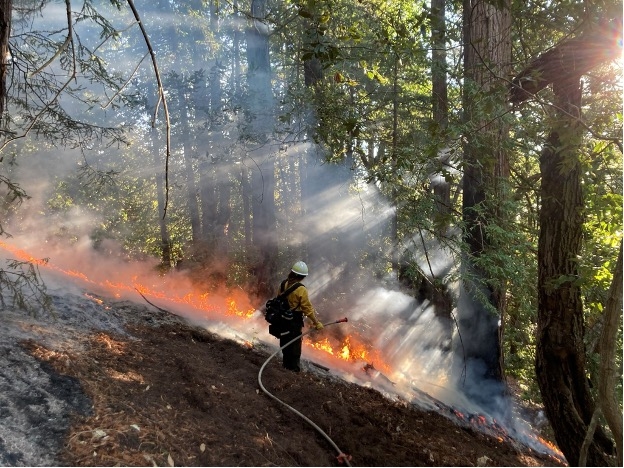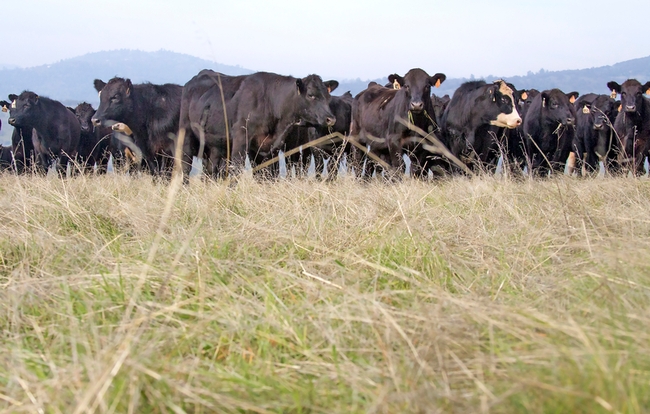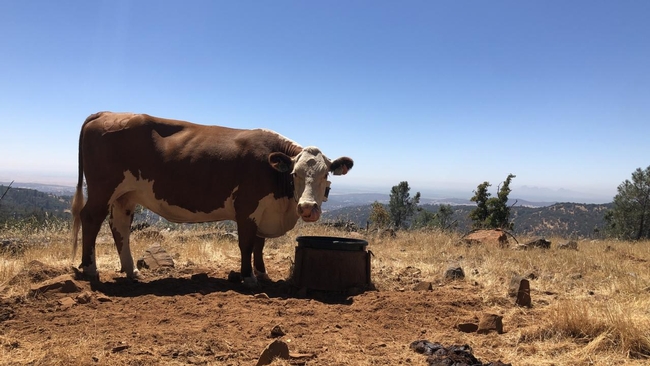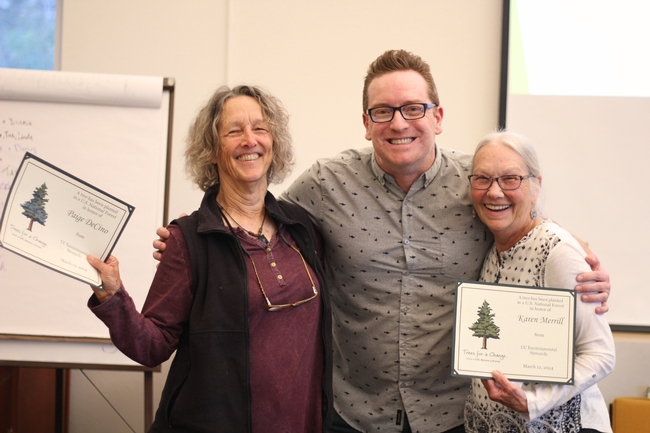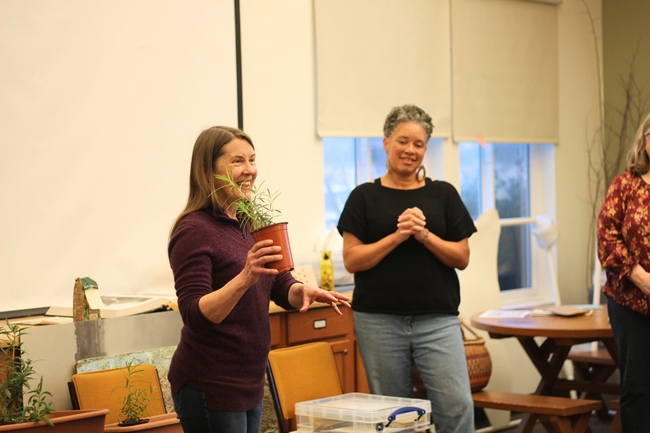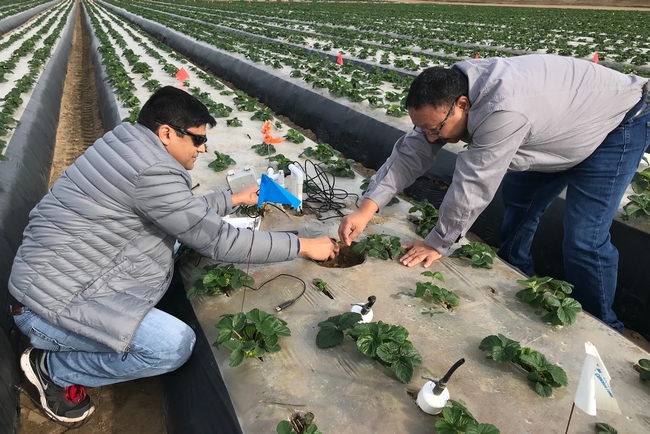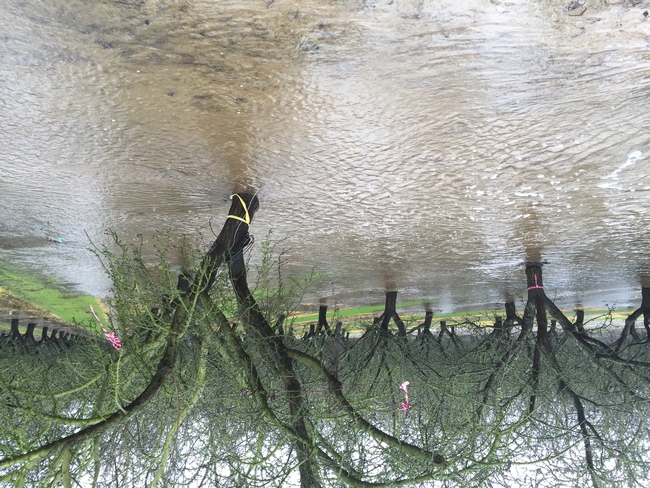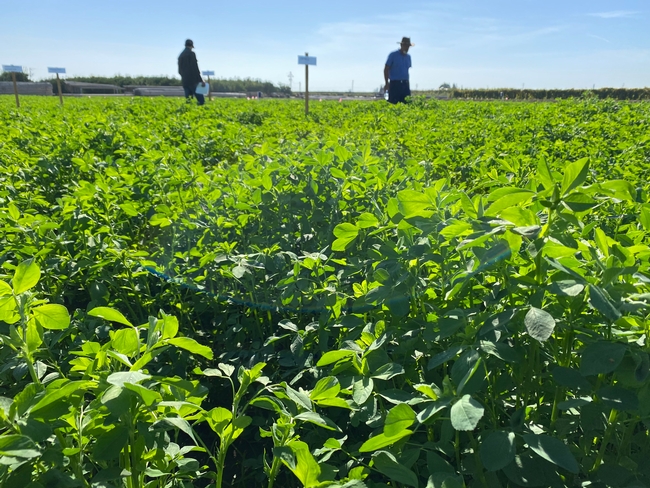Posts Tagged: natural resources
Public invited to observe prescribed fire training in Santa Cruz County
First Forester TREX to be held June 3-6
California's first-ever Forester Prescribed Fire Training Exchange event focused on bringing together professional foresters, forest managers and fire practitioners will occur June 3-6 near Watsonville. The four-day event is being hosted by the Central Coast Prescribed Burn Association, which empowers the public to build a culture of good fire and supports private landowners in conducting prescribed burns in Monterey, San Benito and Santa Cruz counties.
There will be one burn conducted during the event, likely on June 4 or 5, which will be open for the public to observe.
Prescribed Fire Training Exchanges (TREXs) first came to Northern California in 2013, and have made a positive cultural shift concerning prescribed fire, within both regional fire services and the general public. These “good fire” TREX events have drawn significant attention, especially in the context of more severe wildfire seasons.
After months of cross-organizational planning, the four-day long training will be focused on exploring the connections between sustainable forest management, wildfire resilience, timber harvesting, prescribed fire, and will include a burn within a commercially harvested redwood forest. The TREX will provide experiential training opportunities to forest managers and planners to advance statewide knowledge of how to conduct prescribed fire in merchantable timber stands.
Along with the prescribed burn, the program will include lectures, local tours, and open discussions on how to incorporate fire into timber management, burn planning and timber harvest planning, pre- and post-fire considerations, and permitting mechanisms for fire and timber harvesting. Presentations will be given by local forestry consultants, University of California Agriculture and Natural Resources, CALFIRE and local fire practitioners.
The burn location will occur near Mount Madonna, on private land with access allowed for accompanied observation only. Be advised, while the ForesterTREX planning team works closely with theMonterey Bay Air Resources District to assure good smoke dispersal, smoke may be seen and be present in these areas during and after a burn. Please see the Central Coast Prescribed Burn Association webpage at calpba.org/centralcoastpba for updates close to the burn date.
Participants and partners include the Mount Madonna Center, members of the Amah Mutsun Tribal Band and the Esselen Tribe of Monterey County, University of California Agriculture and Natural Resources, Resource Conservation District of Monterey County, CALFIRE, local land trusts, scientists, ranchers, students, researchers, land managers and others. The Central Coast Prescribed Burn Association is currently funded via California Coastal Conservancy grants.
For more information or to join a group of observers, contact Barb Satink Wolfson, UC Cooperative Extension area fire advisor at bsatink@ucanr.edu.
Understanding cattle grazing personalities may foster sustainable rangelands
Matching herds to landscape can support animal growth and ecological needs
Not all cattle are the same when it comes to grazing. Some like to wander while others prefer to stay close to water and rest areas.
Recognizing those personality differences could help ranchers select herds that best meet grazing needs on rangelands, leading to better animal health and environmental conditions, according to a new paper from the University of California, Davis, published in the journal Applied Animal Behaviour Science.
“Cattle can actually be beneficial for the rangelands,” said lead author Maggie Creamer, who recently earned her Ph.D. in animal behavior at UC Davis. “Vegetation in rangelands actually need these kinds of disturbances like grazing.”
Ranchers can add elements to the rangeland such as water, mineral supplements and fencing to influence where cattle graze, but little research has been done on how those efforts affect individual cows. Considering personalities could save money.
“If you're spending all this money to add a management tool in order to change the distribution of your animals, that's a huge cost to ranchers,” said Creamer. “Thinking about other tools, or selecting certain animals with these grazing traits, might be a better way to optimize the distribution on rangeland rather than spending a bunch of money for something that may ultimately not pan out for all your animals.”
Effects of grazing
Livestock graze on an estimated 56 million acres in California, and healthy rangelands host native vegetation and animals, foster nutrient cycling and support carbon sequestration.
Uneven grazing can degrade water quality, soil health and habitats. Optimizing grazing — including the even spread of cow pies — can improve the ecosystem while also reducing fuel loads for wildfires.
To better understand individual grazing patterns, researchers went to the UC Sierra Foothill Research and Extension Center in Browns Valley and tracked 50 pregnant Angus and Hereford beef cows fitted with GPS collars.
The research
The cattle, which were tracked from June to August over two years, had access to 625 acres of grasslands and treed areas ranging in elevation from 600 to 2,028 feet. In the second year, a new watering site was added at a higher elevation.
Across the two years, the cows showed consistent and distinct grazing patterns even when water sources changed. Age and stage of pregnancy did not affect patterns, though cattle tended to clump near water and rest sites on hotter days.
The cows that ventured into higher elevations and farther from watering sites had more variability in their grazing patterns than those that stayed at lower elevations near water. That suggests it may be harder for non-wanderers to adjust to some landscapes.
“Thinking about the topography of your rangeland and your herd of cows can benefit both the animals and the sustainability of the land,” said Creamer, who next month begins work as a postdoctoral scholar in North Carolina.
Gauging personalities
Keying in on personality type may sound difficult, but the researchers also found some clues as to how to pinpoint the wanderers and homebodies. Unlike cattle at feedlots, the breeding cow population, especially on rangelands in California and other western states, live largely “wild” lives and are rarely handled, save for vaccinations and weaning.
Research due to be published later this year found that paying attention to individual cow reactions during those events can help determine personalities. The cows that appeared more passive during those handling interactions tended to be nomadic.
“We found that you can maybe predict those hill climbers if you kind of look at how they act when the veterinarian or rancher handle them,” said senior author Kristina Horback, an associate professor in the Department of Animal Science at UC Davis.
Informing practices
For ranchers, the findings could be invaluable, said Dan Macon, a livestock and natural resources Cooperative Extension advisor in Placer and Nevada counties for UC Agriculture and Natural Resources.
“Any time we can improve our understanding of cattle behavior, particularly at the individual level, it can improve how we handle livestock and manage the landscape,” he said.
Macon said that during the recent drought, it was hard to get cattle into higher country, but if ranchers could have selected the nomads, it may have saved money in terms of ranch labor and other efforts.
“If you ask a rancher who has been attentive to their cattle over many years, they know the personalities,” Macon said.
For Creamer and Horback, the research opens new doors into understanding herd behavior and dynamics, one that could be a cheaper alternative to high-tech solutions.
“Animal science tends to look overlook the mind of the animal when searching for solutions to challenges,” Horback said. “It's always been a direct line to genetics for immunity or nutrition, but nothing about the mind of the animal. And that's such a loss. There's so much we can learn from behavior in the end.”
The Russell L. Rustici Rangeland and Cattle Research Endowment supported the research.
This article was first published on the UC Davis News site.
New UC California Naturalists inspire care for nature in San Diego County
Nearly 200 residents trained in past seven years by program, a part of UC Environmental Stewards
On one of her darkest days, Tammah Watts stood in front of her kitchen sink to fill a pitcher of water. Outside of her window, the San Marcos resident noticed a flutter in the distance. She spotted a small yellow bird emerge from the tree and her eyes grew in admiration.
Bird-watching from her kitchen window became an escape for Watts while she was temporarily homebound after a surgery. It's where she found connection beyond the interior space of her home.
“I started noticing other birds that had always been there. The yard didn't change, but my mind and my perspective did,” she said.
Eager to learn more and expose others to her new hobby and its healing power, Watts joined the University of California Environmental Stewards program, a statewide program housed under UC Agriculture and Natural Resources, to become a certified California Naturalist.
The program offers two environmental education certification courses: the California Naturalist course, which introduces people to the wonders of California's unique ecology and engages the public in the study and stewardship of the state's natural communities, and a separate Climate Stewards course.
One of the many strengths of the program is that it allows people from diverse backgrounds to find common ground in nature even if how they became interested varies, said Eliot Freutel, a community education specialist for the UC Environmental Stewards program in Southern California.
“Our partners that help us administer the course are organizations that already have access to the public and provide informal science education, such as natural history museums or Audubon societies,” Freutel added.
Welcoming a new cohort of environmental stewards
In early March, the longest-standing California Naturalist course in San Diego County graduated 25 new members, Watts being one of them, under Karen Merrill and Paige DeCino's instruction. For seven years, Merrill and DeCino have served as co-instructors at the Buena Vista Audubon Nature Center in Oceanside and graduated 166 members prior to their most recent and final class.
Transitioning into retirement, DeCino and Merrill reflected on their seven years of service and are proud to see younger and more diverse faces join the California Naturalist program. Tucker Shelton, who recently graduated alongside his mom, is among the few young people who have joined the program over the years. A love for nature began when Shelton discovered tide pools when he was just a boy. At 14 years old, Shelton wants to inspire a generation of youth with a passion and care for nature.
“When you're younger and your brain is still developing, you're the most interested in new things. If you find a passion at a young age, you'll most likely grow up with it becoming a part of you,” said Tucker, whose capstone project focuses on an essay about the endangered Townsend's big-eared bat and uses stamp art to raise awareness. His art will be featured and sold at an upcoming exhibit and all proceeds will be donated to the Volcan Mountain Wilderness Preserve in Julian.
Hannah Marquez, another recent graduate, was born and raised in San Diego. She values its cultural diversity and believes connecting the public to nature begins with language. In working with Tecolote Canyon Natural Park and Nature Center in Mission Valley to establish an updated native plant library, Marquez is providing relevant information and resources in English and Spanish.
“A lot of people aren't comfortable using technology, and relying on Google Translate isn't going to cut it,” said Marquez, adding that her parents' limited English inspired this project.
Marquez hopes to interest more people in growing native plants in their backyard and believes accessible information is the first step to doing so.
“This has been so rewarding for us,” said Merrill. “Typically, our students are already involved in the community, but for those who aren't, it's amazing to see them become a part of the community and engage in a way that they haven't before.”
DeCino agreed and said that she really hopes to find new instructors to keep the momentum of California Naturalists in San Diego County alive. “Even though we're retiring, we'll still be around here and there, but its important to us that we pass the torch,” DeCino said.
The future of California Naturalists in San Diego County
What's next for San Diego County, you ask?
“We definitely want to expand in the area. But right now, we're looking for alums who are interested in taking over the program held at Buena Vista Audubon Nature Center,” Freutel said. “I'm also hoping to secure more partnerships throughout San Diego County so that the course is offered in various places, not just North County, which can lead to accessibility concerns.”
Like other students, Marquez commuted an hour, each way, to participate in the UC Environmental Stewards program. “It's a worthwhile course, one that helps people have a positive impact in their own community,” said Freutel.
For Watts, helping people find healing and connection to the world around them – an experience her book, a guide to the powerful healing of bird-watching, discusses – is a priority. “It's not just about watching birds,” she said. “It's about noticing the tree the bird lives in, and the ground the tree is growing in.”
During a nature walk that Watts led for a group of kids, she noticed two sets of footprints in the dirt. Immediately, she could differentiate the two. “One belonged to a raccoon and the other belonged to a deer,” Watts said. “I was so excited that I could tell them apart, and I promise I didn't know this before taking the CalNat course.”
To learn how you can join the UC Environmental Stewards program and become a California Naturalist or Climate Steward, visit: https://calnat.ucanr.edu/Take_a_class/
Water risks to agriculture: Too little and too much
Water is among the most precious resources on the planet. Some areas don't get enough; some get too much. And climate change is driving both of those circumstances to ever-growing extremes.
Two UC Merced experts in civil and environmental engineering took part in a recent report by the Environmental Defense Fund examining the issue and potential solutions. Associate Professor of Extension Tapan Pathak and Professor Josué Medellín-Azuara co-authored the report, "Scarcity and Excess: Tackling Water-Related Risks to Agriculture in the United States," and wrote the section pertaining to California.
In addition to climate change, disruptive human interventions such as groundwater over-extraction, sprawling drainage networks and misaligned governance are driving up water-related agricultural costs, particularly in midwestern and western states, the researchers found.
The problem is magnified in California, which hosts the largest and the most diverse agricultural landscape in the U.S., Pathak and Medellín-Azuara wrote, with gross revenues from farms and ranches exceeding $50 billion.
"Due to the favorable Mediterranean climate, unique regional microclimate zones, a highly engineered and developed water supply system, and a close connection between producers and research and cooperative extension institutions, California's agricultural abundance includes more than 400 commodities, some of which are produced nowhere else in the nation," the UC Merced researchers wrote.
But the state's varying climate and water needs pose a challenge. Though most of the precipitation falls in the northern part of California, the southern two-thirds of the state account for 85% of its water demand. And all of those crops must be watered in the summer, when there is little, if any, rainfall.
Some of the water comes from snowpack developed through winter storms and stored in reservoirs as it melts. Much of it comes from the Colorado River.
"Substantially less water is captured and stored during periods of drought, imperiling California's water supply and putting agricultural water needs at risk," Pathak and Medellín-Azuara wrote.
Climate change, with increasing periods of drought between excessively wet winters, magnifies that risk.
"Further, the rate of increases in the minimum temperatures in the Sierra Nevada is almost three-fold faster than maximum temperatures, resulting in potential decrease in the snowpack, earlier snowmelt, and more water in liquid form as opposed to snow," the researchers wrote. "According to the California Department of Water Resources, by 2100, the Sierra Nevada snowpack is projected to experience a 48% to 65% decline from the historical average."
Climate change is also expected to affect the availability of water from the Colorado River.
Climate extremes such as heat waves, drought and flooding - giving rises to increased weeds, pests and disease - are already significantly impacting agriculture and the broader economy, Pathak and Medellín-Azuara wrote.
The state's drought from 2012 to 2016 led to about 540,000 acres of fallow farmland in 2015, costing the state's economy $2.7 billion in gross revenue and 21,000 jobs. With the lack of precipitation, farmers increasingly pumped groundwater to irrigate crops, depleting those resources.
The report goes on to recommend policies, programs and tools be developed for agricultural resilience, including:
- Changing land use and crop management practices to support a transition to an agriculture footprint that can be sustained by the available water supplies.
- Increasing farmer and water manager access to important data and innovative technological tools to support their efforts.
- Reimagining built infrastructure and better using natural infrastructure so regions are better equipped to handle weather extremes.
- Developing policy and funding mechanisms to support mitigation and adaptation to water-related risks, avoid maladaptation and ensure food and water security.
"California's innovative agriculture needs to rapidly adapt to more volatile water availability, climate-driven higher water demands, and regulation protecting groundwater reserves, communities and ecosystems," Medellín-Azuara said. "The early adoption of more sustainable practices in agriculture will likely pay off dividends both in the short and long terms."
Added Pathak, "California faces significant challenges related to climate change, but it also presents opportunities for innovations, collaborations and sustained growth. To make agriculture resilient to climate risks, we need to engage in holistic solutions that integrates environmental, social, economic and policy considerations."
$1.7M granted for climate-smart planning led by UC ANR scientists
In California, natural and working lands make up 95 million acres of the state and play a vital role in building resilience to the impacts of climate change. University of California Agriculture and Natural Resources was awarded $1.7 million for the California Next Generation and Equitable Climate Action Plan, as part of the state's Natural and Working Lands Climate Smart Strategy and California's 30x30 Initiative, an effort to conserve 30% of the state's lands and coastal waters by 2030.
Natural and working lands include both unmanaged and managed areas actively used for agriculture, forestry or production purposes.
Chandra Richards, UC Cooperative Extension agricultural land acquisitions academic coordinator for Southern California, and Cristina Murillo-Barrick, UCCE's Black, Indigenous and People of Color community development advisor for the Bay Area, are leading the California Next Generation and Equitable Climate Action Plan project.
To build capacity and technical assistance for climate-smart action planning, Richards and Murillo-Barrick will use the Climate Smart Land Management Program funding, awarded through the California Department of Conservation, to focus on two of the most pressing climate action issues: equitable land access and land management diversification.
According to the 2022 U.S. Department of Agriculture census, demographic data indicates that California agricultural land ownership and production is concentrated within an aging and mostly White demographic. However, research suggests diverse management practices promote healthy landscapes. This has been shown to benefit the environment, human health and climate resilience in multiple ways.
For this reason, this project centers on “historically underrepresented communities,” a term that includes California Native American Tribes, communities of color, landless farmers, immigrant and non-English speaking communities and other agency-designated minority groups (racial, ethnic and non-male groups, socially disadvantaged farmers and ranchers, and California designated severely disadvantaged communities).
Focusing on Southern California, UC Cooperative Extension scientists will identify barriers to land access, management and opportunities to increase land manager diversity. They also will engage historically underrepresented communities in coalition building, capacity assessment and climate action planning.
Within the last few decades, Californians have faced increased ecosystem stressors and decreasing diversity of natural systems. This pattern continues to damage already-vulnerable communities (disproportionately historically underrepresented communities), while also worsening and intensifying climate impacts, including drought, wildfire, flooding and disease. Overcoming these kinds of systemic and structural challenges will require the next generation of land managers to reflect California equitably, while preparing them to take on climate resilience. The project will determine clear solutions and plans that enable long-term, strategic land use and protection.
To do this work, UCCE is collaborating with the Community Alliance with Family Farms (CAFF), California Association of Resource Conservation Districts (CARCD) and the California Bountiful Foundation, all of whom serve as subgrantees and will deepen connections with communities.
Organizations like CARCD have long served as “boots on the ground” personnel and have close relationships with landowners and land managers. “RCDs have been hearing the land equity need for a long time and are actively collaborating with different partners to tackle this pressing issue,” said Qi Zhou, program manager of Justice, Equity, Diversity and Inclusion at CARCD and member of the Strategic Growth Council Land Equity Task Force.
“California RCDs are excited about this project because it will allow major California agriculture and conservation partners to collaboratively develop plans and implement projects centering on equity land access and land management diversification,” Zhou added.
Project lead Richards said $270,000 of the grant will be reserved for new partnerships with organizations in Southern California that have experience with, and strong ties to, historically underserved communities.
UC ANR is collaborating with the California Department of Food and Agriculture as well as California Climate and Agriculture Network (CalCAN), and World Be Well, a Southern California nonprofit.
Tawny Mata, CDFA's director of the Office of Environmental Farming and Innovation, described technical assistance providers as being grounded in their local agricultural communities and recognized their importance to partners in the success of CDFA's incentive programs.
“When we do succeed in reaching historically underserved farmers and ranchers with our grant programs, it is often with the thoughtful support and planning of a technical assistance provider,” Mata said. “I look forward to this project helping us refine our own technical assistance funding programs and bringing technical assistance providers together to network and share best practices for improving land access and promoting climate-smart agriculture.”
“The successes of this project will elevate the voices of historically underrepresented communities, strengthening efforts in these communities to support climate action,” said Richards. Additionally, the project will increase sharing of regional reports, needs assessments and community plans surrounding climate-smart management practices. Finally, it will boost technical assistance for these groups specifically.
To learn more about the Climate Smart Land Management Program and this year's awardees, visit:

